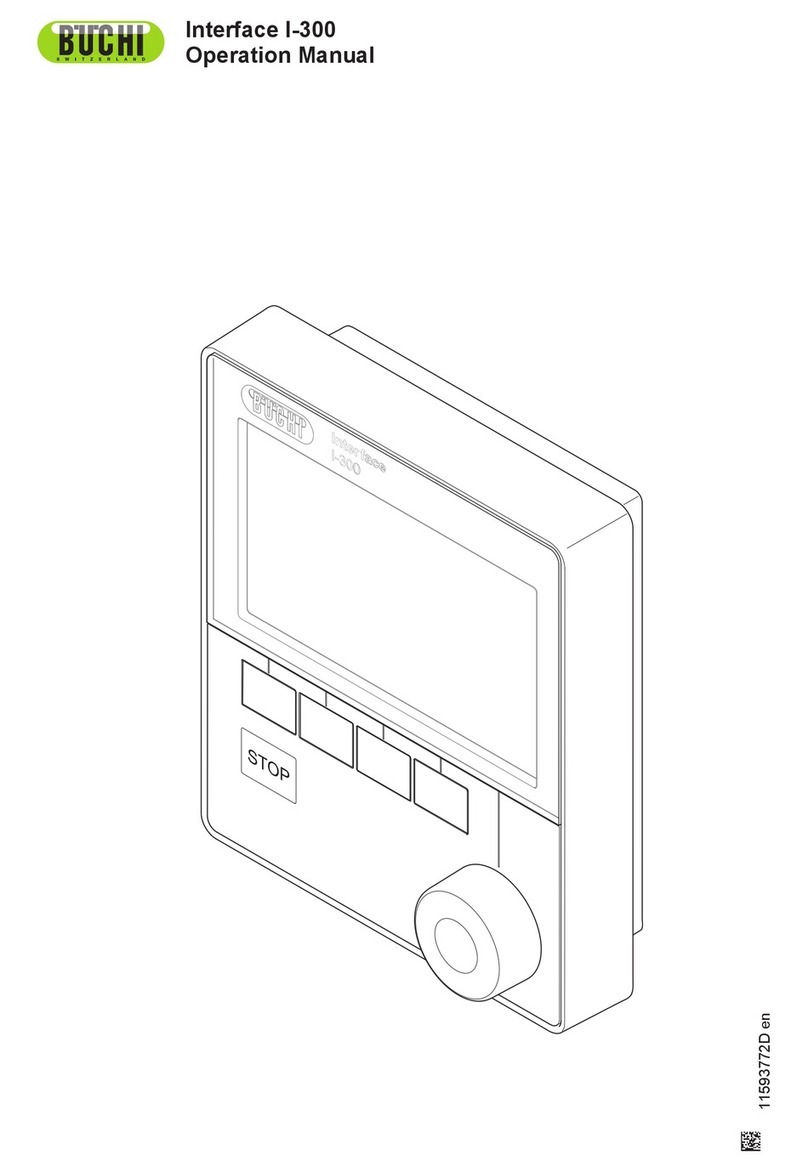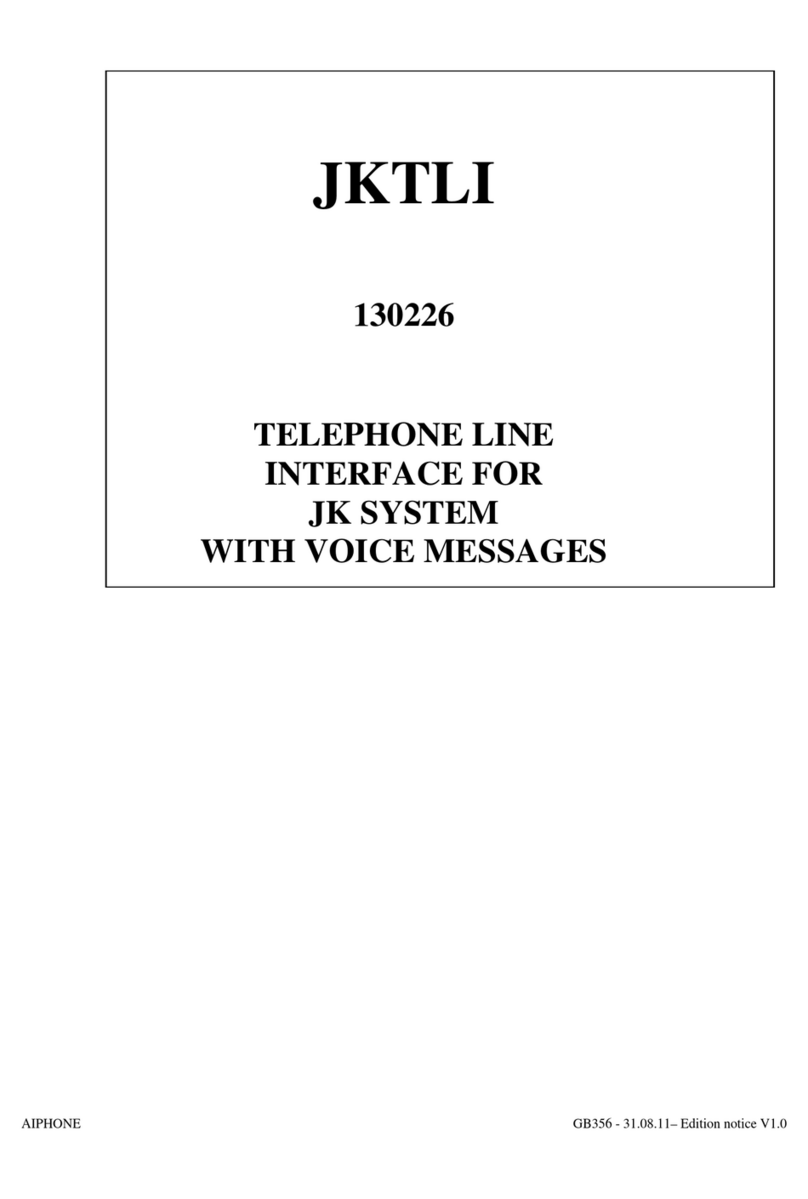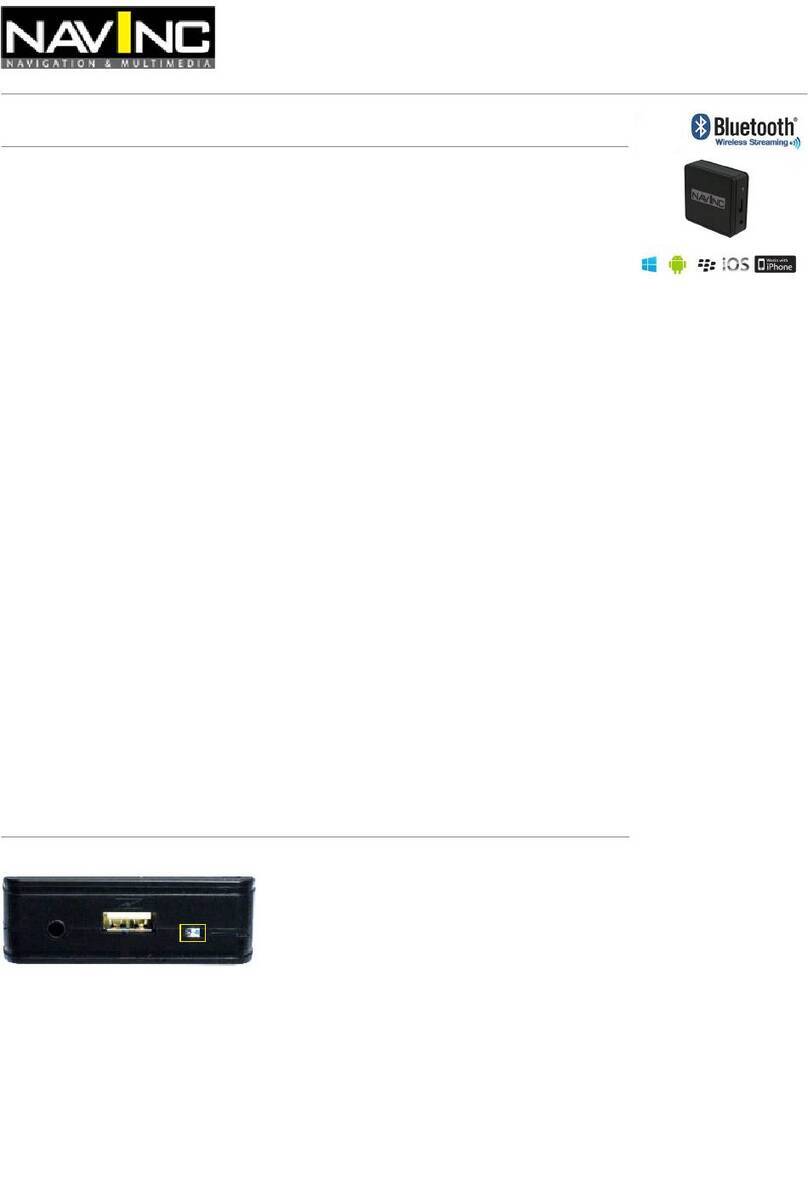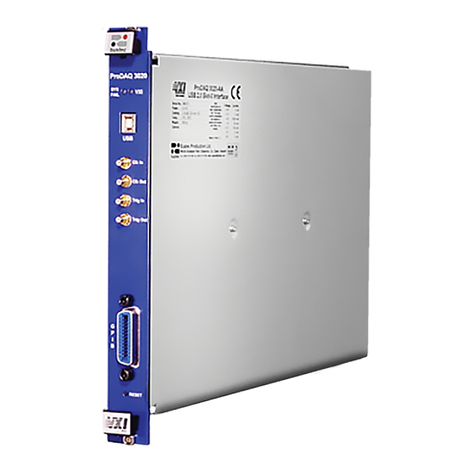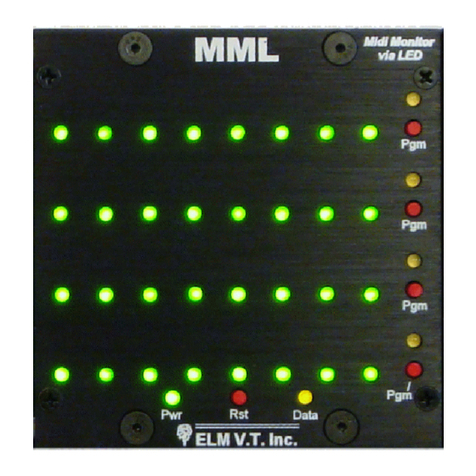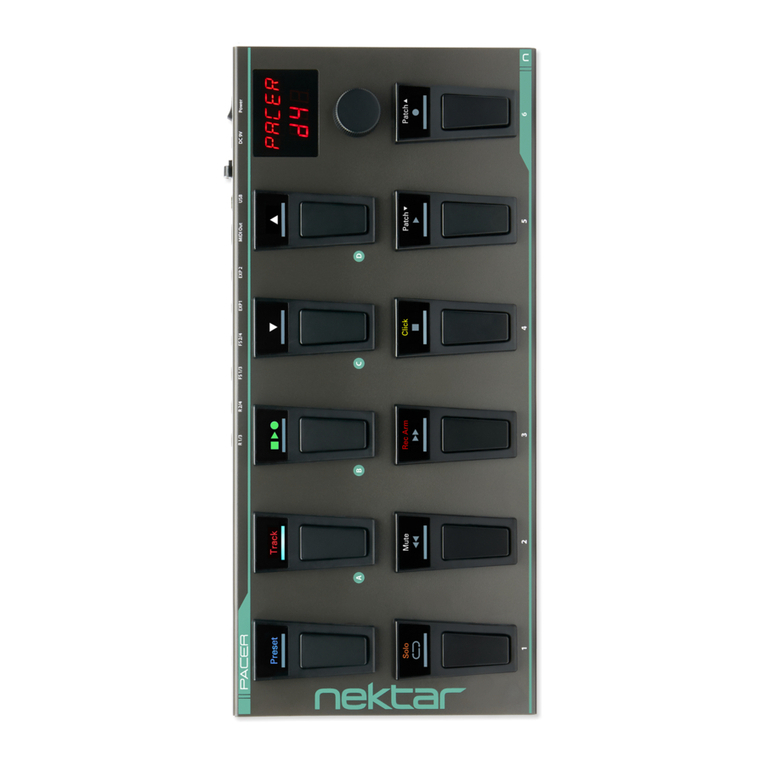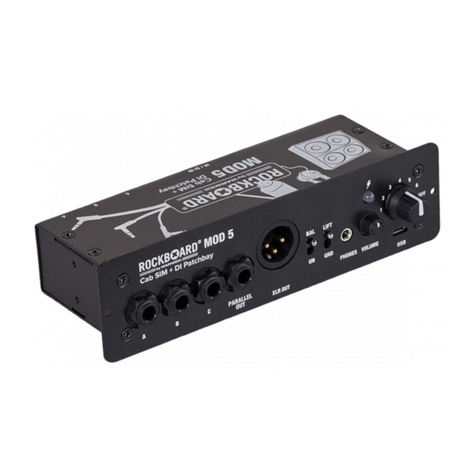Buchi Interface I-300 PRO User manual

Interface I-300 Pro
Operation Manual
STOP
11593781 | E en

Imprint
Product Identification:
Operation Manual (Original) Interface I-300 Pro
11593781
Publication date: 06.2020
BÜCHI Labortechnik AG
Meierseggstrasse 40
Postfach
CH-9230 Flawil 1
E-Mail: [email protected]
BUCHI reserves the right to make changes to the manual as deemed necessary in the light of experi-
ence, especially with respect to structure, illustrations and technical details.
This manual is copyrighted. Information from it may neither be reproduced, distributed, or used for com-
petitive purposes, nor made available to third parties. The manufacture of any component with the aid of
this manual without prior written agreement is also prohibited.

BÜCHI Labortechnik AG Table of contents
Operation Manual Interface I-300 Pro iii
Contents
1 About this document...........................................................................................................6
1.1 Warning notices in this document........................................................................................................ 6
1.2 Symbols............................................................................................................................................... 6
1.2.1 Warning symbols .....................................................................................................................6
1.2.2 Mark-ups and symbols.............................................................................................................6
1.3 Trademarks.......................................................................................................................................... 7
2 Safety....................................................................................................................................8
2.1 Intended use........................................................................................................................................ 8
2.2 Use other than that intended ............................................................................................................... 8
2.3 Staff qualification ................................................................................................................................. 8
2.4 Residual risks ...................................................................................................................................... 9
2.4.1 Faults during operation ............................................................................................................9
2.5 Personal protective equipment ............................................................................................................ 9
2.6 Modifications........................................................................................................................................ 9
3 Product description...........................................................................................................10
3.1 Description of function ....................................................................................................................... 10
3.2 Description of function Cloud Services (Option)................................................................................ 10
3.3 Description of function of Rotavapor R-300 and Rotavapor R-220 Pro controller............................. 10
3.3.1 Control of R-300 and R-220 Pro ............................................................................................10
3.3.2 Parameter display with R-300 and R-220 Pro .......................................................................12
3.4 Description of function for control of the R-300 with and without interface unit/VacuBox ................. 12
3.5 Configuration ..................................................................................................................................... 14
3.5.1 Front view ..............................................................................................................................14
3.5.2 Rear view ...............................................................................................................................15
3.5.3 VacuBox (connections)..........................................................................................................16
3.5.4 LegacyBox (connections)....................................................................................................... 17
3.5.5 Display ...................................................................................................................................19
3.5.6 Type plate ..............................................................................................................................20
3.6 Navigating through the menu system ................................................................................................ 20
3.6.1 Menu bar................................................................................................................................20
3.6.2 Favorites menu ......................................................................................................................21
3.6.3 Operating modes menu .........................................................................................................21
3.6.4 Configuration menu................................................................................................................21
3.6.5 Libraries menu .......................................................................................................................25
3.6.6 Symbols on the status bar .....................................................................................................25
3.7 Scope of delivery ............................................................................................................................... 26
3.8 Technical data ................................................................................................................................... 26
3.8.1 Interface ................................................................................................................................. 26
3.8.2 Junction boxes.......................................................................................................................26
3.8.3 Ambient conditions.................................................................................................................27
3.8.4 Materials ................................................................................................................................27
4 Transport and storage ......................................................................................................28
4.1 Transport ........................................................................................................................................... 28
4.2 Storage .............................................................................................................................................. 28

Table of contents BÜCHI Labortechnik AG
iv Operation Manual Interface I-300 Pro
5 Installation..........................................................................................................................29
5.1 Fitting the Interface I-300/I-300 Pro................................................................................................... 29
5.1.1 Mounting interface on Rotavapor R-300................................................................................ 29
5.1.2 Fitting interface unit on Vacuum Pump V-300 .......................................................................31
5.1.3 Mounting interface unit on Rotavapor R-220 Pro................................................................... 32
5.1.4 Mounting interface unit on laboratory stand (optional accessory).......................................... 33
5.1.5 Mounting interface unit on a wall bracket (optional accessory) .............................................33
5.2 Connecting the Interface I-300/I-300 Pro........................................................................................... 34
5.2.1 Connecting communication cables to interface unit............................................................... 35
5.2.2 Establishing LAN connection .................................................................................................35
5.2.3 Overview: Setting up communication connections (COM)..................................................... 36
5.2.4 Overview: setting up coolant tubing connections...................................................................36
5.2.5 Overview: setting up vacuum tubing connections..................................................................37
5.3 Connecting AutoDest sensor to vapor temperature sensor (optional accessory).............................. 39
5.4 Connecting foam sensor (optional accessory)................................................................................... 40
5.5 Connecting valve unit for external vacuum........................................................................................ 42
5.6 Operating I-300 and I-300 Pro in parallel........................................................................................... 42
6 Operation............................................................................................................................44
6.1 Navigating the menu.......................................................................................................................... 44
6.1.1 Selecting menu items............................................................................................................. 44
6.1.2 Entering parameter settings...................................................................................................45
6.1.3 Changing settings ..................................................................................................................47
6.2 Performing distillation ........................................................................................................................ 47
6.2.1 Overview: typical distillation sequence ..................................................................................48
6.2.2 Basic functions.......................................................................................................................49
6.2.3 Executing Manual mode ........................................................................................................50
6.2.4 Executing Timer mode ...........................................................................................................53
6.2.5 Executing Continuous Pumping mode...................................................................................57
6.2.6 Executing AutoDest mode .....................................................................................................59
6.2.7 Executing Drying mode..........................................................................................................61
6.2.8 Executing Methods mode ......................................................................................................63
6.3 Displaying reading graphs ................................................................................................................. 67
6.4 Recording process data..................................................................................................................... 68
6.4.1 Inserting an SD card ..............................................................................................................69
6.4.2 Activating recording ...............................................................................................................70
6.5 Solvent library.................................................................................................................................... 70
6.5.1 Using the solvent library......................................................................................................... 70
6.5.2 Creating your own solvent library........................................................................................... 72
6.6 Activating eco mode .......................................................................................................................... 73
6.7 Setting hysteresis .............................................................................................................................. 74
6.8 Creating favorites............................................................................................................................... 75
6.9 Activating Come here function........................................................................................................... 76
6.10 Controlling lift position via the interface unit ...................................................................................... 76

BÜCHI Labortechnik AG Table of contents
Operation Manual Interface I-300 Pro v
7 Cleaning and servicing .....................................................................................................77
7.1 Cleaning the casing/display............................................................................................................... 77
7.2 Performing a leak test........................................................................................................................ 77
7.3 Opening leak test history ................................................................................................................... 78
7.4 Fitting GL14 cap nut with tube seal ................................................................................................... 79
7.5 Checking seals .................................................................................................................................. 79
7.6 Checking vacuum seal....................................................................................................................... 80
7.7 Calibrating AutoDest sensor.............................................................................................................. 80
7.8 Calibrating the pressure sensor......................................................................................................... 81
7.8.1 Offset calibration....................................................................................................................82
7.8.2 Simple calibration................................................................................................................... 83
7.8.3 Loading factory calibration..................................................................................................... 84
7.9 Setting up Rotavapor® Open Interface ............................................................................................. 84
8 Help with faults ..................................................................................................................86
8.1 Faults, possible causes and remedies............................................................................................... 86
8.2 Error messages ................................................................................................................................. 86
8.3 Customer service............................................................................................................................... 86
8.4 eSupport ............................................................................................................................................ 87
9 Taking out of service and disposal..................................................................................88
9.1 Taking out of service.......................................................................................................................... 88
9.2 Disposal ............................................................................................................................................ 88
10 Appendix ............................................................................................................................89
10.1 Solvent table...................................................................................................................................... 89
10.2 Spare parts and accessories ............................................................................................................. 90
10.2.1 Accessories............................................................................................................................90
10.2.2 Wearing parts.........................................................................................................................93
10.2.3 Spare parts ............................................................................................................................93
10.3 Health and safety approval................................................................................................................ 94
10.4 Health and safety............................................................................................................................... 94
10.5 Handling data..................................................................................................................................... 96
10.5.1 Counter data ..........................................................................................................................97
10.5.2 Data configuration settings ....................................................................................................97
10.5.3 Data storage period ...............................................................................................................98
10.5.4 Device settings.......................................................................................................................98
10.5.5 Error data ...............................................................................................................................98
10.5.6 Maintenance data ..................................................................................................................98
10.5.7 System configuration data .....................................................................................................98
10.5.8 Distillation process data .........................................................................................................98
10.5.9 Contact data...........................................................................................................................98
10.5.10Location data .........................................................................................................................98
11 Accessories .......................................................................................................................99

1 | About this document BÜCHI Labortechnik AG
6/102 Operation Manual Interface I-300 Pro
1 About this document
This operation manual is applicable for all variants of the instrument.
Read this operation manual before operating the instrument and follow the instruc-
tions to ensure safe and trouble-free operation.
Keep this operation manual for later use and pass it on to any subsequent user or
owner.
BÜCHI Labortechnik AG accepts no liability for damage, faults and malfunctions re-
sulting from not following this operation manual.
If you have any questions after reading this operation manual:
uContact BÜCHI Labortechnik AG Customer Service.
https://www.buchi.com/contact
1.1 Warning notices in this document
Warning notices warn you of dangers that can occur when handling the device. There
are four danger levels, each identifiable by the signal word used.
Signal word Meaning
DANGER Indicates a danger with a high level of risk which could result in
death or serious injury if not prevented.
WARNING Indicates a danger with a medium level of risk which could result in
death or serious injury if not prevented.
CAUTION Indicates a danger with a low level of risk which could result in mi-
nor or medium-severity injury if not prevented.
NOTICE Indicates a danger that could result in damage to property.
1.2 Symbols
The following symbols are displayed in this operation manual or on the device:
1.2.1 Warning symbols
Symbol Meaning
General warning
1.2.2 Mark-ups and symbols
NOTE
This symbol draws attention to useful and important information.
RThis character draws attention to a requirement that must be met before the in-
structions below are carried out.
uThis character indicates an instruction that must be carried out by the user.
ðThis character indicates the result of a correctly carried out instruction.
Mark-up Explanation
Window Software Windows are marked-up like this.
Tab Tabs are marked-up like this.

BÜCHI Labortechnik AG About this document | 1
Operation Manual Interface I-300 Pro 7/102
Mark-up Explanation
Dialog Dialogs are marked-up like this.
[Button] Buttons are marked-up like this.
[Field names] Field names are marked-up like this.
[Menu / Menu item] Menus or menu items are marked-up like this.
Status Status is marked-up like this.
Signal Signals are marked-up like this.
1.3 Trademarks
Product names and registered or unregistered trademarks that are used in this docu-
ment are used only for identification and remain the property of the owner in each
case.

2 | Safety BÜCHI Labortechnik AG
8/102 Operation Manual Interface I-300 Pro
2 Safety
2.1 Intended use
The Interface I-300 Pro is intended for indicating vacuum within an operating range of
0mbar to ambient atmospheric pressure. The measurement and regulation of the
vacuum is performed by means of a VacuBox. The Interface I-300 Pro has been de-
signed and built as an item of laboratory equipment and can be used in conjunction
with the following devices:
Distillation apparatus, especially rotary evaporators
Vacuum-drying cabinets
Vacuum pumps
Recirculating chiller
2.2 Use other than that intended
Use of any kind other than that described in the section Intended use and any appli-
cation that does not comply with the technical specifications (see Chapter3.8 "Tech-
nical data", page26) constitutes use other than that intended.
In particular, the following applications are not permissible:
Use of the device in areas that require apparatus that is safe to use in potentially
explosive atmospheres.
Use as a calibration device for other equipment.
Operation at pressures above atmospheric
Damage or hazards attributable to use of the product other than as intended are en-
tirely at the risk of the user alone.
2.3 Staff qualification
Unqualified persons are unable to identify risks and are therefore exposed to greater
dangers.
The device may only be operated by suitably qualified laboratory staff.
These operating instructions are aimed at the following target groups:
Users
Users are persons that meet the following criteria:
They have been instructed in the use of the device.
They are familiar with the contents of these operating instructions and the applica-
ble safety regulations and apply them.
They are able on the basis of their training or professional experience to assess
the risks associated with the use of the device.

BÜCHI Labortechnik AG Safety | 2
Operation Manual Interface I-300 Pro 9/102
Operator
The operator (generally the laboratory manager) is responsible for the following as-
pects:
The device must be correctly installed, commissioned, operated and serviced.
Only suitably qualified staff may be assigned the task of performing the operations
described in these operating instructions.
The staff must comply with the local applicable requirements and regulations for
safe and hazard-conscious working practices.
Safety-related incidents that occur while using the device should be reported to the
manufacturer ([email protected]).
BUCHI service technicians
Service technicians authorized by BUCHI have attended special training courses and
are authorized by BÜCHI Labortechnik AG to carry out special servicing and repair
measures.
2.4 Residual risks
The device has been developed and manufactured using the latest technological ad-
vances. Nevertheless, risks to persons, property or the environment can arise if the
device is used incorrectly.
Appropriate warnings in this manual serve to alert the user to these residual dangers.
2.4.1 Faults during operation
If a device is damaged, sharp edges, moving parts or exposed electrical wires can
cause injuries.
uRegularly check device for visible damage.
uIf faults occur, switch off the device immediately, unplug the power cord and in-
form the operator.
uDo not continue to use devices that are damaged.
2.5 Personal protective equipment
Depending on the application, hazards due to heat and/or corrosive chemicals may
arise.
uAlways wear appropriate personal protective equipment such as safety goggles,
protective clothing and gloves.
uMake sure that the personal protective equipment meets the requirements of the
safety data sheets for all chemicals used.
2.6 Modifications
Unauthorized modifications may impair safety and lead to accidents.
uUse only genuine BUCHI accessories, spare parts and consumables.
uTechnical modifications to the device or accessories should only be carried out
with the prior written approval of BÜCHI Labortechnik AG and only by authorized
BUCHI technicians.
BUCHI accepts no liability whatsoever for damage arising as a result of unauthorized
modifications.

3 | Product description BÜCHI Labortechnik AG
10/102 Operation Manual Interface I-300 Pro
3 Product description
3.1 Description of function
The Interface I-300 Pro is designed for indicating, adjusting and controlling the com-
plete distillation system. The Interface I-300 Pro settings enable precise specification
of the individual process parameters. For example:
Rotation speed of the evaporating flask
Specified temperature of the heating bath
Specified temperature of the coolant
Specified vacuum pressure
Duration of the distillation process
The pressure is measured and regulated by the associated VacuBox. Measurement
is independent of the solvent used.
3.2 Description of function Cloud Services (Option)
Dongle LAN App System owner
X X
X X
X x* X X
X x* X X
X
* Option
NOTE
4For update details, see "Firmware Update Quick Guide "
4For details of Monitor app, see "BUCHI Monitor App Quick Guide "
4For details of eSupport, see Chapter8.4 "eSupport", page87
4For details of OpenInterface see Chapter7.9 "Setting up Rotavapor® Open Inter-
face", page84
3.3 Description of function of Rotavapor R-300 and Rotavapor R-220
Pro controller
3.3.1 Control of R-300 and R-220 Pro
The Rotavapor R-300 and R-220 Pro can both be controlled by the Interface I-300
Pro.
The following table details the common features and the differences in the control of
the Rotavapor R-300 and Rotavapor R-220 Pro

BÜCHI Labortechnik AG Product description | 3
Operation Manual Interface I-300 Pro 11/102
Rotavapor R-300 Rotavapor R-220 Pro
Interface unit
mounting
Option: I-300 or I-300 Pro
mounted on Rotavapor arm, see
Chapter5.1.1 "Mounting inter-
face on Rotavapor R-300",
page29.
Ready mounted: I-300 Pro
mounted on device directly adja-
cent to internal display, see
Chapter5.1.3 "Mounting inter-
face unit on Rotavapor R-220
Pro", page32.
Information on
display
Full display of figures and
graphs on display of I-300 Pro.
Display of figures and graphs
split between I-300 and R-220
Pro.
Lift control Manual and programmed control
of lift position possible, see
Chapter6.10 "Controlling lift po-
sition via the interface unit",
page76.
Manual adjustment of lift posi-
tion possible, see Chapter6.10
"Controlling lift position via the
interface unit", page76.
Communica-
tion cable con-
nection
See operating instructions for
the Rotavapor R-300.
See operating instructions for
the Rotavapor R-220 Pro.
Connections External valves connected to
VacuBox, Chapter5.5 "Connect-
ing valve unit for external vac-
uum", page42.
External valves connected di-
rectly to R-220 Pro.
[Manual] oper-
ating mode
Distillation carried out with man-
ually set parameters. See Chap-
ter6.2.3 "Executing Manual
mode", page50
Distillation carried out with man-
ually set parameters. See Chap-
ter6.2.3 "Executing Manual
mode", page50
[Timer] mode Distillation carried out with man-
ually set parameters. See Chap-
ter6.2.4 "Executing Timer
mode", page53
Distillation carried out with man-
ually set parameters. See Chap-
ter6.2.4 "Executing Timer
mode", page53
[Continuous
pumping]
For drying the system after dis-
tillation. See Chapter6.2.5 "Exe-
cuting Continuous Pumping
mode", page57
For drying the system after dis-
tillation. See Chapter6.2.5 "Exe-
cuting Continuous Pumping
mode", page57
[AutoDest]
mode
For carrying out automatic sin-
gle or multi-stage distillation.
See Chapter6.2.6 "Executing
AutoDest mode", page59
For carrying out automatic sin-
gle or multi-stage distillation.
See Chapter6.2.6 "Executing
AutoDest mode", page59
[Drying] mode Drying of the sample after distil-
lation possible. See Chap-
ter6.2.7 "Executing Drying
mode", page61.
[Drying] mode is not available
for the R-220 Pro.
[Methods]
mode
Distillation carried out according
to a sequence of programmed
steps. See Chapter6.2.8 "Exe-
cuting Methods mode",
page63
Distillation carried out according
to a sequence of programmed
steps. See Chapter6.2.8 "Exe-
cuting Methods mode",
page63
[eSupport] For details of sending a ticket to
the local BUCHI technical engi-
neer, see Chapter8.4 "eSup-
port", page87
The submenu [eSupport] is not
available for the R-220 Pro.

3 | Product description BÜCHI Labortechnik AG
12/102 Operation Manual Interface I-300 Pro
Rotavapor R-300 Rotavapor R-220 Pro
[Rotavapor
Open Inter-
face]
Rotavapor® Open Interface pro-
vides the facility for an overall
view of the status of various in-
struments and communication
between them.See Chapter7.9
"Setting up Rotavapor® Open
Interface", page84
The submenu [Rotavapor Open
Interface] is not available for the
R-220 Pro.
3.3.2 Parameter display with R-300 and R-220 Pro
The parameters for the current distillation process are shown on the home screen of
the Interface I-300 Pro. Depending on which Rotavapor the interface unit is con-
nected to, different parameters may be shown. Below is a comparison of the R-300
and R-220 Pro Rotavapors:
Parameter Information R-300 R-220 Pro
Vacuum Current system pressure
Desired system pressure
✔ ✔
Rotation Current rotation speed
Desired rotation speed
✔(✔)*
Heating bath Current heating bath temperature
Desired heating bath temperature
✔(✔)*
Recirculating
chiller
Current system temperature
Desired system temperature
✔ ✔
Vapor Current vapor temperature ✔(✔)*
Lift Raise lift
Lower lift
✔(✔)**
* With the Rotavapor R-220 Pro these parameters are not shown if the reduced dis-
play option (display split between internal Rotavapor display and interface unit) is acti-
vated.
** Lift position not displayed with R-220 Pro.
3.4 Description of function for control of the R-300 with and without
interface unit/VacuBox
The Rotavapor R-300 can be operated with or without an Interface I-300 Pro.

BÜCHI Labortechnik AG Product description | 3
Operation Manual Interface I-300 Pro 13/102
Without interface unit/VacuBox With interface unit/VacuBox
Vacuum pump
delivery
No vacuum control Current system pressure
shown on display (home
screen)
Setting and display of speci-
fied vacuum
Evaporating
flask rotation
speed
Rotation speed set using con-
trol knob
Current rotation speed not
shown on heating bath base
Rotation speed set using con-
trol knob
Current rotation speed shown
on display (home screen) and
on heating bath base
Heating bath
temperature
Current temperature shown
on display on heating bath
base
Required temperature set us-
ing control knob on heating
bath base
Current and set temperature
shown on display (home
screen) of interface unit and
on heating bath base
Required temperature set us-
ing control knob on heating
bath base
Recirculating
chiller temper-
ature
Current coolant temperature
shown on display on device
Required temperature set us-
ing control knob on device
Current system temperature
shown on display (home
screen) and on device
Required temperature set us-
ing control knob on device
Vapor temper-
ature
No display of vapor tempera-
ture possible
Vapor temperature shown on
display (home screen)
Lift position Lift position set by means of
"vertical adjustment handle"
Lift position set by means of
"vertical adjustment handle"
Lift position set by means of
"Up" and "Down" buttons on
home screen

3 | Product description BÜCHI Labortechnik AG
14/102 Operation Manual Interface I-300 Pro
3.5 Configuration
3.5.1 Front view
STOP
1
2
3
Fig.1: Front view of Interface I-300 Pro
1 Touch-screen display 3 Navigation control
2 STOP button (emergency stop)

BÜCHI Labortechnik AG Product description | 3
Operation Manual Interface I-300 Pro 15/102
3.5.2 Rear view
2
3
1
4
6
5
Fig.2: Rear view of Interface I-300 Pro
1 LAN port 4 Slot for BUCHI SD card
2 BUCHI standard communication port
(COM)
5 USB connection (not used)
3 Locating lug for bracket 6 MicroSD card (not used)

3 | Product description BÜCHI Labortechnik AG
16/102 Operation Manual Interface I-300 Pro
3.5.3 VacuBox (connections)
Other BUCHI laboratory equipment is connected to the Interface I-300 Pro in series
together with the VacuBox. The individual devices are connected to one another via
the standard BUCHI communication port (7). See Chapter5.2.3 "Overview: Setting
up communication connections (COM)", page36.
1
1
3
4
5
6
7
1
2
Fig.3: Connections on the VacuBox
1 Vacuum connection 5 Connection for vapor temperature/Au-
toDest sensor (VT/AS)
2 Venting valve/inert gas connection
(optional)
6 Foam sensor connection (FS)
3 Water coolant valve connection (CW) 7 Standard BUCHI communication port
(COM)
4 Connection for valve unit or straight-
way valve (VALVE)
NOTE
Connecting VacuBox with R-220 Pro:
If the Interface I-300 Pro and the VacuBox are operated in the Rotavapor R-220 Pro
system, the following points should be noted: The external valves must always be
connected to the Rotavapor R-220 Pro even if there is an alternative connection on
the VacuBox.

BÜCHI Labortechnik AG Product description | 3
Operation Manual Interface I-300 Pro 17/102
3.5.4 LegacyBox (connections)
Connection of a LegacyBox is required whenever legacy BUCHI laboratory equip-
ment is to be controlled via the Interface I-300 Pro. The LegacyBox is connected to
the distillation system using a standard BUCHI communication cable and has other
connection options such as an RS-485 communication port. There is also the option
of incorporating pumps of other makes in the Rotavapor system and controlling them
via the interface. In that case, the pump requires a 0 – 10 V input.
The LegacyBox is fixed to a Rotavapor R-300 or a laboratory stand clamp.
2
4
3
1
6
5
Fig.4: Connections on the LegacyBox
1 Standard BUCHI communication port
(COM)
4 RS-232 (not used)
2 0 – 10 V communication port – for
connecting pumps of other makes
5 External power supply – for genuine
BUCHI mains adaptor, 30 V, 30 W
(see Accessories)
3 RS-485 communication port – for
connecting legacy BUCHI laboratory
equipment (Vacuum Pumps V-700 /
V-710, Rotavapors: R-210 / R-215,
Recirculating Chiller F-1xx)
6 On/Off switch
NOTE
The external power supply is only necessary if the LegacyBox is not connected to a
Rotavapor or a vacuum pump and is used for other vacuum control applications in-
stead. Otherwise the vacuum pump or the Rotavapor supplies the LegacyBox with
power.
0 – 10 V communication port
This connection comprises a 0 – 10 V output for connecting pumps of other makes
and electrically isolated relay contacts. There is also a valve control contact.

3 | Product description BÜCHI Labortechnik AG
18/102 Operation Manual Interface I-300 Pro
Fig.5: 8-pin MiniDin pin assignment, view of socket
Pin
8-pin notation
Symbol Description
1 Ground Ground connection for valve and 10 V
output
2 Valve Vacuum valve connection
3 Spare
4 10 V output 0 – 10 V (max. 20 mA, min. 500 Ohm)
5 Relay In Max. 30 V 2 A, electrically isolated
6 Spare
7 Spare
8 Relay Out Max. 30 V 2 A, electrically isolated
S Shield Shield, connected to ground

BÜCHI Labortechnik AG Product description | 3
Operation Manual Interface I-300 Pro 19/102
3.5.5 Display
1
2
4
3
5
1
6
8
9
7
10
1
1
1 Status bar 6 Current setting (e.g. vacuum)
2 Menu bar 7 Direct intervention buttons
3 Current reading (e.g. vacuum) 8 Scroll bar
4 Lift position 9 Lift control
5 Function buttons (context-dependent) 10 Graph display area
NOTE
While distillation is in progress, the display is shown in inverse type. A progress bar
for each process parameter shows the status on reaching the specified setting con-
cerned.

3 | Product description BÜCHI Labortechnik AG
20/102 Operation Manual Interface I-300 Pro
3.5.6 Type plate
The type plate is on the rear of the Interface I-300 Pro.
BÜCHI Labortechnik AG
CH-9230 Flawil/Switzerland
Type: I-300
SN: 1000000000
Volt: 30 VDC
Frequ.:
Power: 3 W
Built: 2014
Made in Switzerland
3
7
2
1
5
4
6
8
9
1011
9
Fig.6: Type plate (example)
1 Company name and address 7 Year of manufacture
2 Device name 8 Country of manufacture
3 Serial number 9 Approvals
4 Input voltage 10 Symbol for "Do not dispose of as
household waste"
5 Frequency 11 Product code
6 Maximum power rating
NOTE
The VacuBox and the LegacyBox each have their own type plate on the rear.
3.6 Navigating through the menu system
3.6.1 Menu bar
The menus are represented by symbols on the menu bar.
The following menus are available:
Symbol Meaning Sub-items
Home screen Process control parameters
Graphs
Favorites Bookmarks for frequently used individual
starting points
Operating modes [Manual]
[Timer]
[Continuous pumping]
[AutoDest]
[Drying]
[Methods]
Other manuals for Interface I-300 PRO
1
This manual suits for next models
2
Table of contents
Other Buchi Recording Equipment manuals
Popular Recording Equipment manuals by other brands
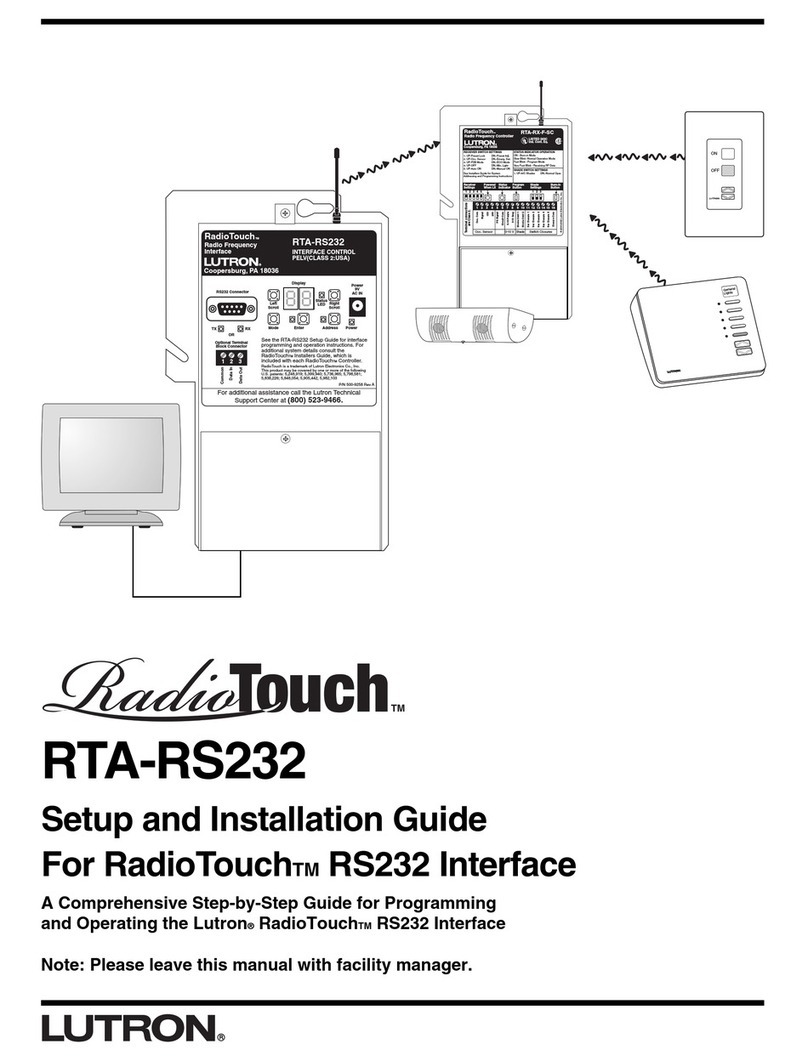
Lutron Electronics
Lutron Electronics RadioTouch RTA-RS232 Setup and installation guide

Asparion
Asparion D400 manual
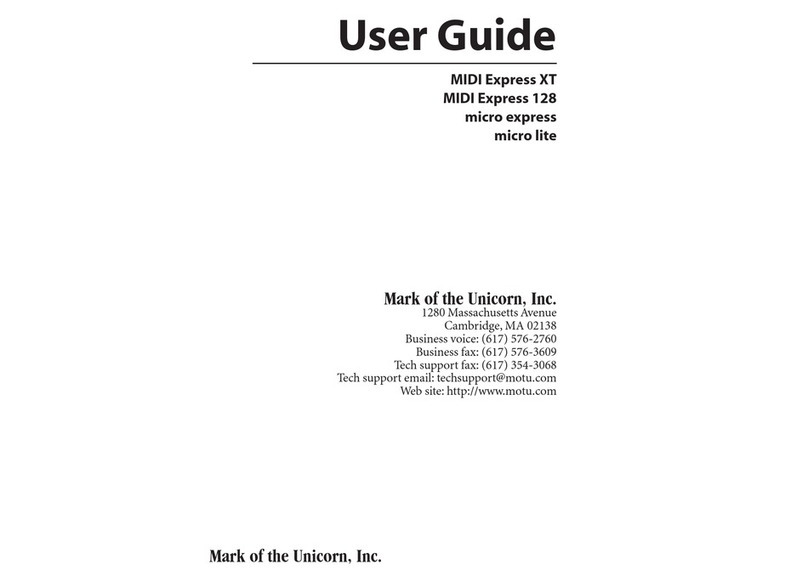
MOTU
MOTU micro express user guide

IntesisBox
IntesisBox LG-RC-MBS-1 installation instructions
iCON Pro Audio
iCON Pro Audio Upod Pro user manual
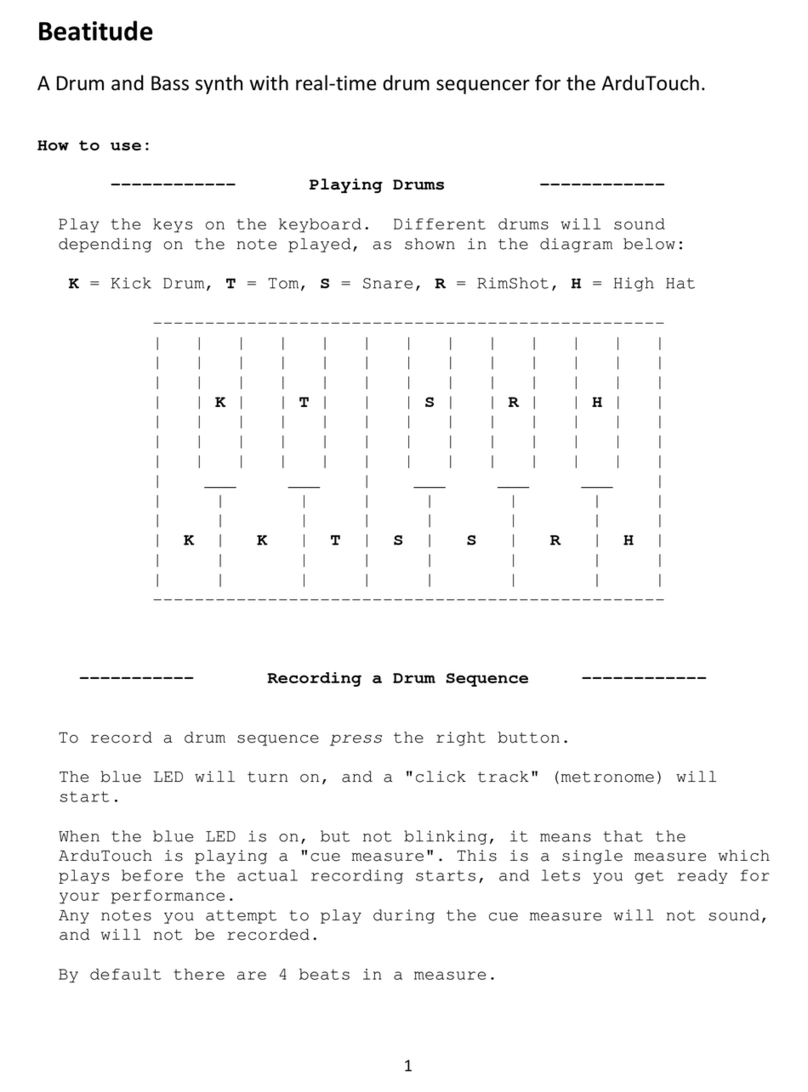
CORNFIELD ELECTRONICS
CORNFIELD ELECTRONICS Beatitude manual

